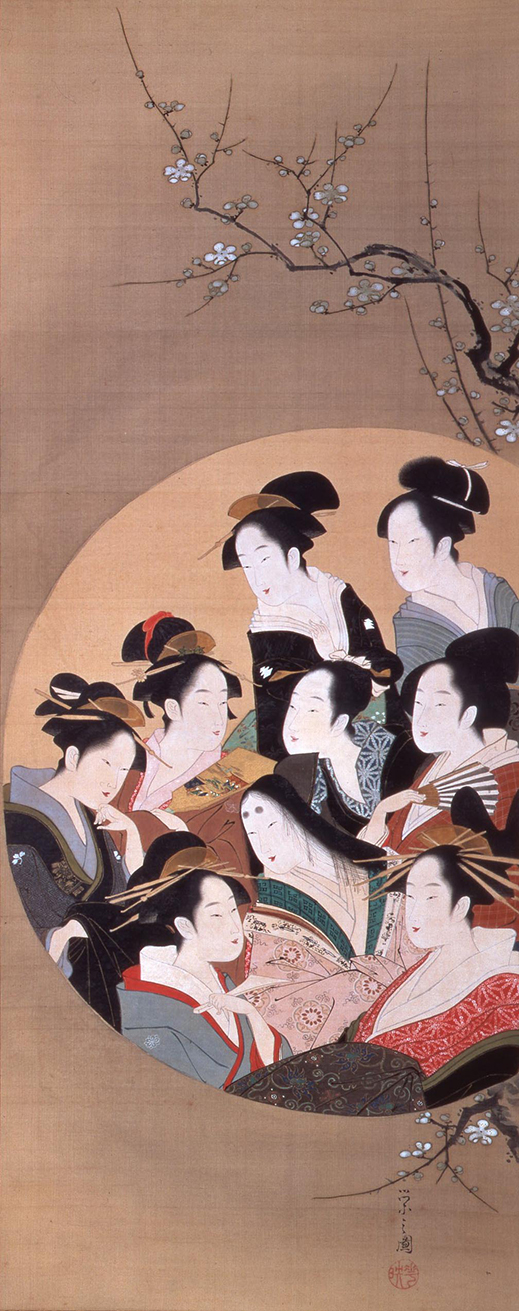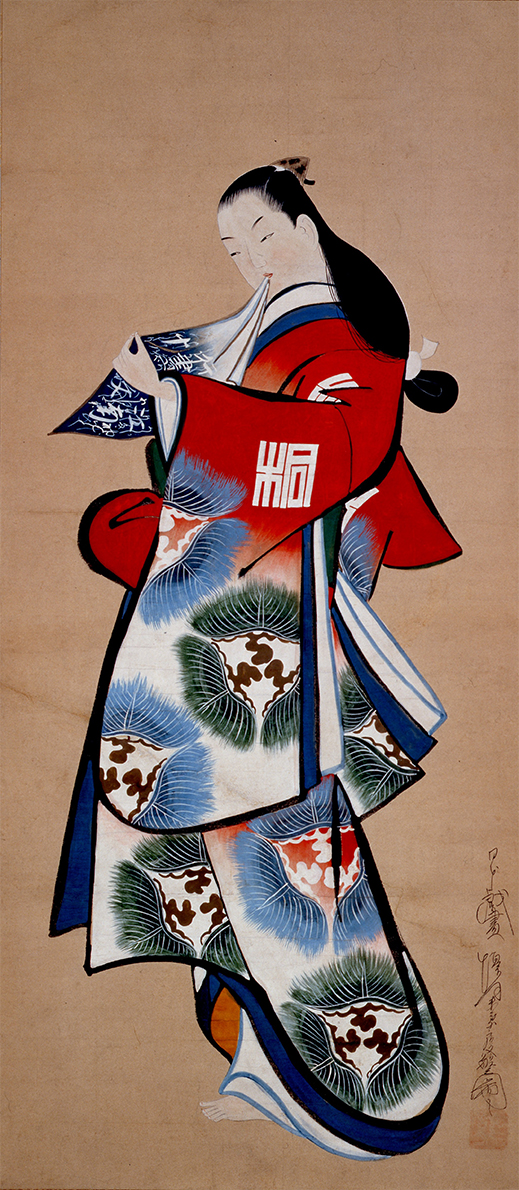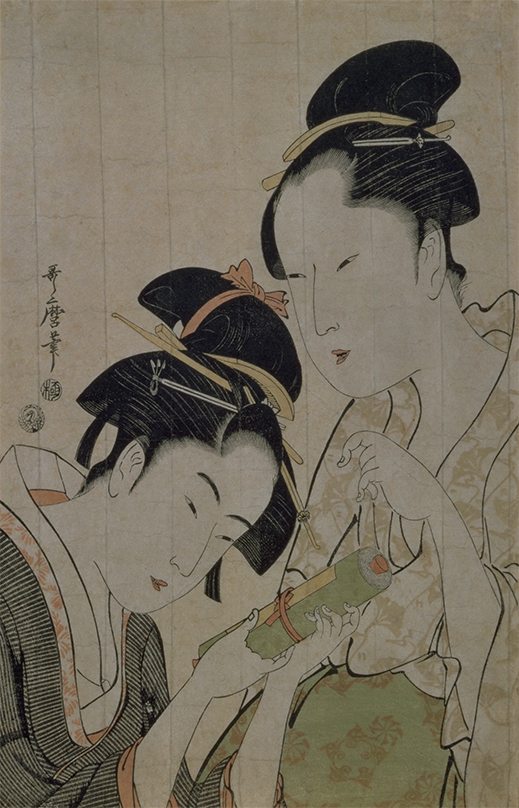 |
 |
 |
HOME > FOCUS > Flashing Style, Celebrating Beauty: Edo-Period Cultural Icons |
 |
 |
Focus features two in-depth reviews each month of fine art, architecture, and design exhibitions at art museums, galleries, and alternative spaces around Japan. |
|
|
 |
 |
 |
Flashing Style, Celebrating Beauty: Edo-Period Cultural Icons
J.M. Hammond |
 |
Kitagawa Utamaro, Eight Views of Tea Stalls in Celebrated Places, ca. 1796, woodblock print |
With Tokyo museums closed and restaurants shutting early, the simple pleasure of dressing up for a day out has been taking a hit. If you are looking to tog up and get out to visit an exhibition, you might consider heading for the coastal town of Atami, a journey of less than two hours from Tokyo, to check out The dapper, the seductive - top stars of Edo glamour at the MOA Museum of Art.
The exhibition brings together roughly 80 artworks -- mainly woodblock prints and paintings -- that will take you out of the current state of reality and transport you to the colorful and fashionable Floating World of the Edo period (1603-1867). Two popular figures of Edo culture are the main focal point here: the kabuki actor, and the kind of stylish and beautiful woman found working in the Yoshiwara pleasure quarters or in the teahouses of the Shogunate's capital.
The exhibition opens not with a depiction of any of these cultural icons, but with a note of mystery -- a painting of various kimono and other garments hanging on a clothes rack. Pictures of this kind, known as tagasode (literally "whose sleeves?"), were popular during the Edo period and encouraged the viewer to imagine in their mind's eye the beautiful woman who wore these items.
A cross-section of the beauties of the age -- potential owners of the tagasode clothing, even -- are depicted in an intriguing composition on display here, Nine Beauties in a Round Window by Chobunsai Eishi. The picture brings together in a purely imaginary space women of different social status who would be highly unlikely to meet in real Edo society -- among them a courtesan, the wife of a samurai, a tea house maiden, the daughter of a merchant, and a geisha. The composition speaks to the rage during this period for comparing, and often ranking, various types of beauties.
 |
|
 |
|
|
|
|
Chobunsai Eishi, Nine Beauties in a Round Window, ca. 1796, hanging scroll, color on silk
|
|
Katsushika Hokusai, Two Beauties, early 19th century, hanging scroll, color on silk, Important Cultural Property |
Another work in this vein is Beauties of Kyoto, Osaka and Edo by Okamura Toshinobu. Although it is probably difficult for viewers today to make out the difference, the triple portrait purportedly pits the gentle elegance of a Kyoto beauty against the emotional Osaka type and the stylish seductress of Edo.
These regional variations in beauty aside, the bijin-ga -- pictures of beautiful women -- in the exhibition focus almost exclusively on Edo, the de facto capital of Japan that gave its name to the era in question. The majority of the featured artists were based there and their works celebrate the joys of the city, particularly those to be found in Yoshiwara, Edo's legendary pleasure quarters.
In his ink-on-paper painting A House of Pleasure at Yoshiwara District, Miyagawa Choki introduces the environment some of the beauties of the day operated in. Here two women in the house play the shamisen to attract customers, as a samurai -- a potential client -- stands outside, perhaps weighing the offer to join the fun.
Many of these pictures, however, take a closer view of the handsome faces and stylish garments of these fashionable women, in single or sometimes double portraits. Two Beauties by Katsushika Hokusai, the only work in the exhibition by the popular artist, shows one woman standing and another sitting down, both displaying elegant, gently curvilinear figures in their richly-colored kimono.
As is the case in this work from late in the master's career, the identities of the women depicted in some of these pictures remain anonymous. More often, however, artists of the period would delight in portraying specific figures from the pleasure houses or tea stalls. There are numerous examples of this here, like the striking Standing Beauty by Kaigetsudo Dohan, whose subject is identified by the writing on the woman's sleeve as Kiri, believed to be a courtesan from Yoshiwara.
 |
|
 |
|
|
|
|
Kaigetsudo Dohan, Standing Beauty, 18th century, hanging scroll, color on paper
|
|
Kitagawa Utamaro, Two Beauties on a Pier, ca. 1798, hanging scroll, color on silk |
As well as focusing on these women's beautiful faces and gorgeous attire, artists also had to come up with imaginative poses for their subjects in order to make memorable compositions. In Two Beauties on a Pier, the renowned Kitagawa Utamaro has his geisha and her attendant waiting for the boat on which they are likely booked to provide entertainment, as suggested by the luggage they carry.
In Shinohara of the Tsuruya, the same artist poses the famed courtesan -- whom he portrayed more than once during his career -- with a young girl playing with a doll.
Utamaro's favorite beauty, however, was Okita of the Naniwaya teahouse, the subject of many of his prints. In one of these on display here, Ofuji and Okita, she is depicted with Ofuji of the Hon'yanagi toothpick shop, who was celebrated for her looks in her youth.
In a scene that owes more to the artist's imagination than historical fact, Ofuji, in her mature years, is handing Okita a scroll, believed to represent the secrets of remaining beautiful.
 |
|
 |
|
|
|
|
Kitagawa Utamaro, Shinohara of the Tsuruya, 18th century, woodblock, nishiki-e
|
|
Kitagawa Utamaro, Ofuji and Okita, ca. 1793, woodblock print, nishiki-e |
In another work, Okita of the Teahouse Naniwaya and the Actor Segawa Kikunojo, Utamaro brings the two worlds of the female beauty and the male kabuki actor together, albeit in a fantasy meeting. Female roles in kabuki were, and still are, played by male actors, and Segawa was famed for his ability to play the part of a seductive woman. So the concept of this work seems to be to juxtapose two images of feminine beauty -- one genuinely female, the other a female impersonator in costume.
|
 |
|
|
|
Utagawa Toyokuni, Ichikawa Danjuro VII, 1812, woodblock print, nishiki-e
|
There are half a dozen other prints of kabuki actors in the show, including Utagawa Toyokuni's arresting portrait of Ichikawa Danjuro VII, whose specialty was playing the roles of male heroes. The inclusion of such images does not, at first, seem to fit in with the fixation on female beauty in evidence so far, but highlights the other stated interest of the exhibition in "the dapper" -- as kabuki actors were the stylish, trendsetting pop stars of the day. Here the focus is on the male actors' eye-catching costumes, evocative facial expressions and, when depicted in mid-performance, their dramatic poses.
In comparison with the attention lavished on bijin-ga, however, this look at actors feels a little underdeveloped, as the exhibition comes to something of an abrupt end without a satisfying conclusion: when you move to the next floor expecting more images of these kabuki heartthrobs, or perhaps more examples of feminine elegance, you are met with a display of Buddhist statues from the museum's permanent collection. Still, The dapper, the seductive offers an intriguing window on the Edo period's obsession with beauty and style, and an opportunity to put on your own finest threads for a day out.
All images courtesy of the MOA Museum of Art.
|
 |
 |
J.M. Hammond
J.M. Hammond researches modernity in Japanese art, photography and cinema, and teaches in Tokyo, including as a faculty lecturer in the English department at Meiji Gakuin University and at Gakushuin University. He has written about art for The Japan Times for over a decade. His essays include "A Sensitivity to Things: Mono No Aware in Late Spring and Equinox Flower" in Ozu International: Essays on the Global Influences of a Japanese Auteur (Bloomsbury, 2015) and "The Collapse of Memory: Tracing Reflexivity in the Work of Daido Moriyama" for The Reflexive Photographer (Museums Etc, 2013) [reprinted in the same publisher's 10 Must Reads: Contemporary Photography (2016)]. He has given various conference papers, including at the University of Hong Kong and the University of Oxford. |
|
 |
|
|
 |
|
 |
|